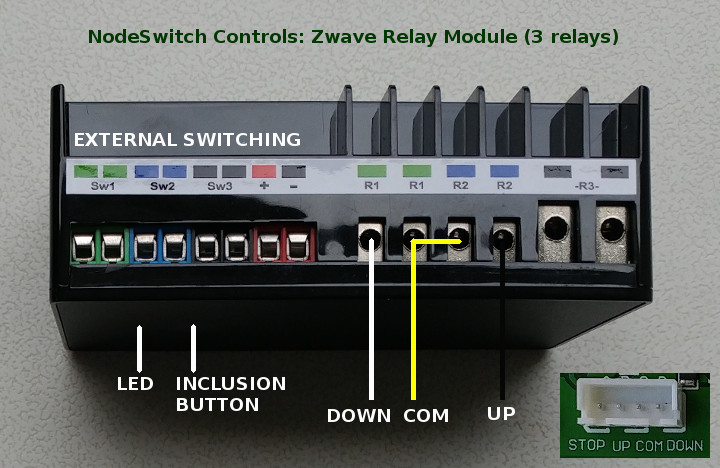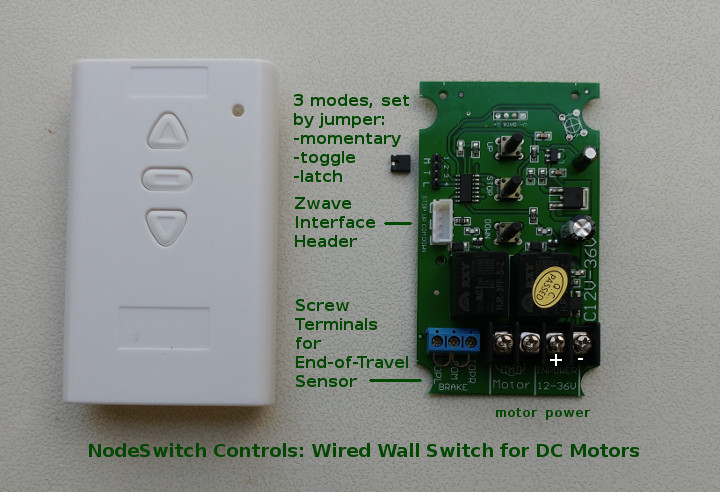Z-Wave Control of Motors: Wiring the Interface
We have 2 methods of controlling our window actuators and blind motors with Z-Wave: Group Transmitter VS Wired Switch. The following table explains the difference between the 2 systems:
| Feature | Group Transmitter | Wired Switch |
|---|---|---|
| Wall Mount & Handheld Radio Remotes | Yes, multiple control locations also allowed | No |
| Unified Enclosure | Yes, plug and play, after inclusion | No, additional wiring required. |
| Extended Range | Yes, will reach anywhere in a typical home | No, Z-wave struggles to reach all parts of a typical home, but improves as you add more Zwave devices due to signal forwarding capabilities (mesh). |
This is part 2 of the instructions for our Z-Wave combination using the wired switch method. Please note that our wireless hand-held and wall remotes do not work with this approach.
- The Z-Wave (DCC-ZW-12MT) relay module with 3 independant controllable relays.
- The wired wall switch (DCC-1W-12-24) for DC reversible motors that interfaces with the above relay module.
In order to produce a functioning unit for motor control, you need to be able to do some wiring to connect these units with your window opener or blind motors. If you prefer a wireless system that can also use our hand-held and wall mount wireless remote controls, please see our home page for the wireless "plug and play" controller.
Here is a picture of the Z-Wave 3 relay module (DCC-ZW-12MT), configured to use 2 relays to control motorized window openers. We have superimposed a picture of the wired switch in the lower right hand corner. The important thing to note are the connections from the Zwave relay module to the wired switch interface:
- DOWN OR CLOSE (white) is wired to relay 1, COMMON (yellow) is wired to both relays, and UP OR OPEN (black) is wired to relay 2.
- It does not matter if you reverse the OPEN or CLOSE wires, it will simply reverse the motor operation.
- Note that the STOP wire is not used because as soon as you release the button, the motor will STOP in momentary mode.
- The actual switch control buttons can be used as an over-ride for testing purposes.

Setting Up The Z-Wave Relay Module With Your Zwave Hub
The inclusion process is quite simple and straightforward:
- 1. Set your hub into "inclusion" mode ...
- 2. Press the inclusion button 3 times ... LED will start flashing and inclusion follows automatically.
- 3. If the LED is not flashing, it usually means that the 3 button presses were not quick enough.
- 4. After a successful inclusion, you should have 3 independant relay switches, plus a master.
- 5. To exclude the device, the process is the same as inclusion (press 3 times, with hub in exclusion mode).
Creating Scenes For The Z-Wave Relay Module With Your Zwave Hub
To use Zwave, please time a full excursion of your window opener or blind motor, then create "scenes" that hold the button on, then turn off after a full excursion. These scenes will become your "FULL OPEN" and "FULL CLOSE" scenes. You can also create other scenes for 25%, 50%, 75% openings that suit your application by timing those excursions.
Here is the full picture of the wired wall switch for reversing DC motors, repeated for reference purposes:

Connecting Your Motors
At this point you can connect your motor to the MOTOR terminals, if you haven't already done so. It does not matter how you connect those wires, but if you find it is working the opposite way to what you want, simply reverse the connection. Here is an example of our standard actuators, but we also have heavy duty units for heavy skylights:

Connecting a Power Supply
You will need to connect a DC power supply to the + and - terminals marked in the switch picture. We have up to 8 amp power supplies (12v) that can power 4 of these actuators simultaneously.
A Word About Digital Radio Signal Range
We have tested a single installation here with about 50 feet of range with the Zwave hub on the same floor as the controller, with about 3 rooms in between (typical wood frame/sheetrock home construction).
It is important to understand that the Zwave radio signal that is transmitted from your Zwave hub to the relay module is not as powerful as our wireless controller, so it is a good idea to place your Zwave hub in a central location in your home or office.
Also, keep in mind that most Zwave devices are also 'signal forwarders' (including the unit in our relay module) so adding more devices in your home should improve the Zwave range results.
If you are dealing with a concrete or cinder block structure, please note that your radio signals will not have as much range.
Purchase These Units in Our Online Store
You can purchase our Z-Wave group controller for blinds and window openers, and our other control products in our online DIY automation store at our sister company.
Adrian Biffen
Senior Partner
NodeSwitch™ Controls
We sincerely hope you enjoy our advanced technology products; if you have any questions, please contact us at any time!
Z-Wave Controller Article Series
Part 1: Z-Wave Motor Control: Introduction
Part 2: Z-Wave Motor Control: Wiring the Interface, Setting Up Your Zwave Hub (you are here)

 Shopping Cart Home - Start Here
Shopping Cart Home - Start Here Z-Wave Motor Control
Z-Wave Motor Control Remote Controls for Radio Equipped Motors
Remote Controls for Radio Equipped Motors DIY Starter Kits for Window Shades
DIY Starter Kits for Window Shades DIY Starter Kits for Window Openers
DIY Starter Kits for Window Openers Alexa & Broadlink RM4 Pro Home Theater Control
Alexa & Broadlink RM4 Pro Home Theater Control Zwave Motor Control: Introduction
Zwave Motor Control: Introduction Shelly WiFi Wireless Motor Control
Shelly WiFi Wireless Motor Control Zigbee Motor Control (Under Development)
Zigbee Motor Control (Under Development) Raspberry Pi as a Home Automation Hub
Raspberry Pi as a Home Automation Hub Hubitat Elevation & Broadlink RM Pro Emitter
Hubitat Elevation & Broadlink RM Pro Emitter Blind Motors
Blind Motors Window Openers
Window Openers Skylight Openers
Skylight Openers Shade Slider
Shade Slider Curtain Closer
Curtain Closer Track Glider
Track Glider Background & Mission Statement
Background & Mission Statement Customer DIY Testimonials
Customer DIY Testimonials Contact Page
Contact Page